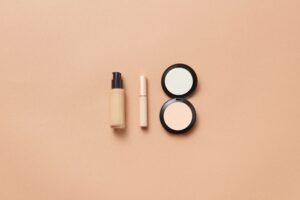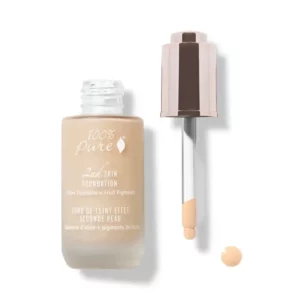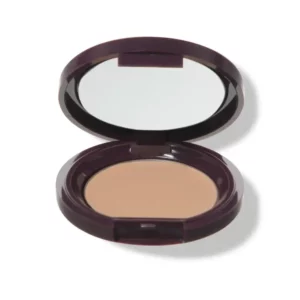Concealer, Foundation, or Both?

In the world of makeup, concealer and foundation are like the dynamic duo working together to create a flawless canvas. However, they serve different purposes and offer varying levels of coverage. While some makeup enthusiasts swear by one, others consider both essential. In this beauty blog, we’ll delve into the world of concealer and foundation, examining their unique roles and helping you decide which one should wear the coverage crown.
The Basics: Concealer and Foundation
Before we dive into the comparison, let’s establish a clear understanding of what concealer and foundation are:
Foundation
Foundation is a makeup product designed to create an even base for the rest of your makeup. It comes in various forms, including liquid, cream, powder, and stick. Foundations provide a uniform skin tone, cover minor imperfections, and create a smooth surface. They come in a range of coverage levels, from sheer to full.
Fruit Pigmented® 2nd Skin Foundation

Concealer
Concealers are more targeted than foundations. They are typically thicker and have higher pigmentation, making them ideal for covering specific imperfections like blemishes, dark circles, redness, and scars. Concealers come in various forms, including liquid, cream, and stick, and they offer different types of coverage, such as light, medium, or full.
Fruit Pigmented® Long Last Concealer with Super Fruits

Coverage Showdown: Concealer vs. Foundation
Now, let’s explore the factors that determine which product should take the coverage crown:
1. Purpose
- Concealer: Concealer is designed for spot-treating specific imperfections. It’s perfect for hiding blemishes, dark under-eye circles, and small areas of discoloration.
- Foundation: Foundation, on the other hand, creates an even complexion across your entire face. It’s the base on which you build your makeup look. While it does provide some coverage, it’s not meant to tackle significant imperfections on its own.
2. Coverage Level
- Concealer: Concealers typically offer higher coverage. They are formulated to be pigmented and thick, which allows them to effectively camouflage imperfections.
- Foundation: The coverage level of foundation varies depending on the formula. You can find sheer, medium, and full-coverage foundations. Sheer foundations even out your skin tone but may not cover blemishes or dark circles completely. Medium and full-coverage foundations offer more camouflage for imperfections.
3. Texture
- Concealer: Concealers tend to be thicker and denser to provide effective coverage. The texture can vary depending on the type of concealer (liquid, cream, or stick).
- Foundation: Foundations come in various textures. Liquid foundations are lightweight, cream foundations are thicker, and powder foundations are, well, powdery. The choice of texture often depends on your skin type and desired finish.
4. Application
- Concealer: Concealer is typically applied to specific areas that need coverage. You can use a brush, sponge, or your fingers to blend it in. When using concealer under your eyes, the “triangle” application method is popular for brightening and concealing dark circles.
- Foundation: Foundation is applied to your entire face, often using a brush, sponge, or fingertips. The goal is to create an even canvas, so the coverage is distributed broadly.
5. Layering
- Concealer: Concealer can be layered over foundation. This is a common practice when you need extra coverage for specific imperfections, especially for events or photos.
- Foundation: Foundation provides the base for your makeup look. You can layer other makeup products, such as concealer or color correctors, on top of it to address individual concerns.
6. Finish
- Concealer: Concealers usually have a matte or satin finish, which helps cover imperfections effectively.
- Foundation: The finish of the foundation varies depending on the formula. You can find matte, satin, dewy, or natural finishes, allowing you to choose the one that best suits your desired look.
When to Use Which?
Now that we’ve compared concealer and foundation, let’s discuss when to use each or both:
- For Everyday Makeup: If you have relatively clear skin and want a natural look, you can often skip foundation and use concealer to spot-treat any imperfections. This approach provides a more lightweight feel and a “no-makeup” makeup look.
- For Special Occasions: When you want a flawless, full-coverage finish, it’s common to use both foundation and concealer. Apply foundation first to create an even canvas, then use concealer to cover blemishes, dark circles, and any other imperfections.
- For Quick Touch-Ups: Throughout the day, you can use concealer to touch up specific areas where your makeup may have faded or blemishes that have reappeared.
- For Minimal Makeup: If you prefer minimal makeup, you can use concealer to even out your skin tone and cover imperfections, skipping foundation entirely.
The decision between concealer and foundation ultimately depends on your individual needs and the look you want to achieve. They are not mutually exclusive; in fact, they often work best together to create a flawless canvas. The coverage crown goes to the product that helps you achieve your desired look. So, whether it’s concealer, foundation, or both, embrace these makeup essentials as your tools for enhancing your beauty and confidence.




